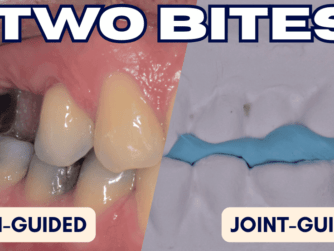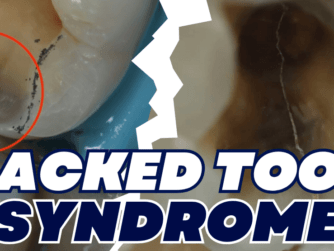Podcast: Play in new window | Download (Duration: 57:49 — 81.9MB)
Subscribe: RSS
How to do Deep Margin Elevation? What are the most important factors in achieving high bond strengths for our restorations? I sometimes look at modern onlay preps and think, ‘God MUST exist’, because I think it’s a miracle how these flat, table-top onlays stay on! I am joined by a world-famous educator in Biomimetic and Adhesive Dentistry: Dr David Gerdolle
David Gerdolle, based in Switzerland, introduced me to contemporary ceramic onlays 8 years ago. It took me 3 years to convince myself the techniques would work in my hands! In this episode I want to fast-forward your progress so you can gain more perspective on adhesive restorations and DME (Deep Margin Elevation).
Protrusive Dental Pearl: How can you show patients what shorter anterior teeth might look like to them discing them down? Use a black Sharpie marker, colour in the part of the edge (maybe 0.5-1mm) that you’re considering removing. Take photograph and show it to them! It helps if their mouth is open for the photo so we see the dark backdrop of the oral cavity.
With the knowledge of Dr. David Gerdolle and biomimetic dentistry, we discussed how it is possible to bond a material to the tooth structure in those ‘table-top’ style, flat onlays.
It doesn’t happen magically. It’s about the nitty gritty detail, the micro steps and respecting certain criterias.
“If you don’t remember anything of your bonding protocol, just remember that, it has to be clean and rough” – Dr. David Gerdolle
Clean and Rough, that’s it right there!
In this episode, we also talked about:
- Failures in using biomimetic dentistry and what we can learn from that
- How these restorations have resistance form
- Bonding protocol step-by-step for adhesive dentistry
- Deep Margin Elevation – how to do it
As promised, DM me on Instagram @protrusivedental for the PDF copy of the steps of deep margin elevation.
If you enjoyed this episode, then do check out Dr. David Gerdolle for more courses.
You might also enjoy Ceramic Onlays from Preps, Temporisation and Bonding Protocols by Nik Sethi!








[…] You might also enjoy another Biomimetic Episode: I Can’t Believe This Sticks – EXTREME BONDING EXPOSED with Dr. David Gerdolle […]